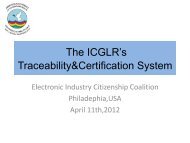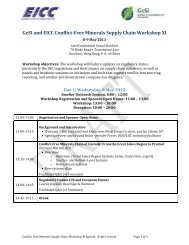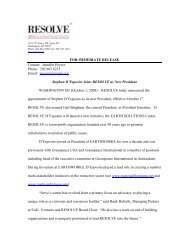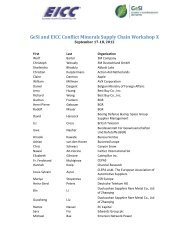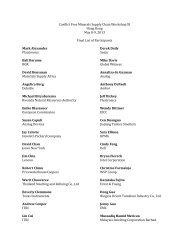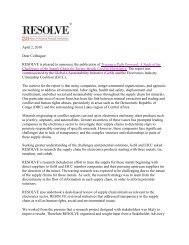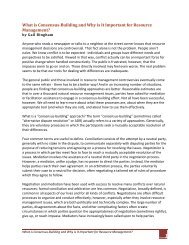Toward SuSTainabiliTy: The roleS and limiTaTionS of ... - Resolve
Toward SuSTainabiliTy: The roleS and limiTaTionS of ... - Resolve
Toward SuSTainabiliTy: The roleS and limiTaTionS of ... - Resolve
Create successful ePaper yourself
Turn your PDF publications into a flip-book with our unique Google optimized e-Paper software.
Chapter 2: Actors – Business 40Chapter 2, Section C<strong>The</strong> Roles <strong>and</strong> Drivers <strong>of</strong> Business<strong>The</strong> last three decades have witnessed a radical transformation in the global businessenvironment. In place <strong>of</strong> local labor markets <strong>and</strong> regional trade systems, large companiesnow operate through integrated networks that span the globe <strong>and</strong> transcend nationalboundaries. International companies now source, manufacture, <strong>and</strong> sell multiple productsin multiple markets across multiple time zones.In this environment, big br<strong>and</strong>s <strong>and</strong> retailers experiencea range <strong>of</strong> new <strong>and</strong> <strong>of</strong>ten complex risks,opportunities, <strong>and</strong> responsibilities. In particular,operating in foreign markets presents companieswith new ethical issues, arising from the differingsocial <strong>and</strong> environmental conditions <strong>and</strong> normsin developing countries (Samuel & Douglas,1996). To manage ethics-related risks, companieshave developed a range <strong>of</strong> corporate responsibilitypolicies <strong>and</strong> strategies, including voluntaryenvironmental management systems, statements<strong>of</strong> ethics, codes <strong>of</strong> conduct, <strong>and</strong> annual reporting<strong>of</strong> their corporate responsibility <strong>and</strong> sustainabilityefforts (Auld, Bernstein, & Cashore, 2008; alsosee Appendix L).St<strong>and</strong>ards <strong>and</strong> certification systems are part <strong>of</strong>this context. Participating companies—especiallythose at the top <strong>of</strong> supply chains in the retail<strong>and</strong> fast-moving consumer goods (FMCG) 1 sectors—haveviewed such systems as a means <strong>of</strong>improving their suppliers’ environmental <strong>and</strong>social practices, ensuring access to sustainablesupplies <strong>of</strong> scarce natural resources, enablingmarket access to institutional or business-tobusinessbuyers, <strong>and</strong> providing assurance toconsumers. Such systems also have the potentialto help companies identify problems, build capacityfor change, increase the rate <strong>of</strong> organizational1 Fast-moving consumer goods companies manufactureinexpensive products that consumers buy on a regularbasis, such as supermarket foods <strong>and</strong> toiletries.learning, <strong>and</strong> facilitate the inculcation <strong>of</strong> newvalues <strong>and</strong> norms (see Appendix L).This final section <strong>of</strong> Chapter 2 describes the rolestypically played by firms in st<strong>and</strong>ards <strong>and</strong> certificationsystems (in addition to the obvious role <strong>of</strong>“participant”); four attitudes toward certificationthat businesses may adopt; the drivers for <strong>and</strong>barriers to business involvement in st<strong>and</strong>ards<strong>and</strong> certification systems; <strong>and</strong> key questionscompanies may want to ask themselves whenconsidering certification. Boxes 2.3–2.11 provideillustrative case examples. 2This section focuses primarily on large br<strong>and</strong>s<strong>and</strong> retailers. <strong>The</strong> motivations <strong>of</strong> enterprises thatproduce <strong>and</strong> supply certified goods <strong>and</strong> services,as well as those <strong>of</strong> the traders <strong>and</strong> other middletierplayers in the supply chain, are not coveredin detail. This bias reflects the current state <strong>of</strong>knowledge regarding st<strong>and</strong>ards <strong>and</strong> certificationsystems—i.e., most studies have looked at toptiercompanies that are purchasers <strong>of</strong> certifiedgoods. Also, these are the types <strong>of</strong> businessesrepresented on the Steering Committee, uponwhose real-world experience the section is partiallybased.2 Many <strong>of</strong> the boxes describe certification programs initiated<strong>and</strong> run by corporations or industry associations.<strong>The</strong>se initiatives typically differ from the multi-stakeholderst<strong>and</strong>ards <strong>and</strong> certification models, which are the focus<strong>of</strong> most <strong>of</strong> this report, in their form <strong>of</strong> governance. <strong>The</strong>information for these examples was drawn primarily fromcompany sources, <strong>and</strong> their inclusion does not implySteering Committee endorsement.<strong>Toward</strong> Sustainability: <strong>The</strong> Roles <strong>and</strong> Limitations <strong>of</strong> Certification



